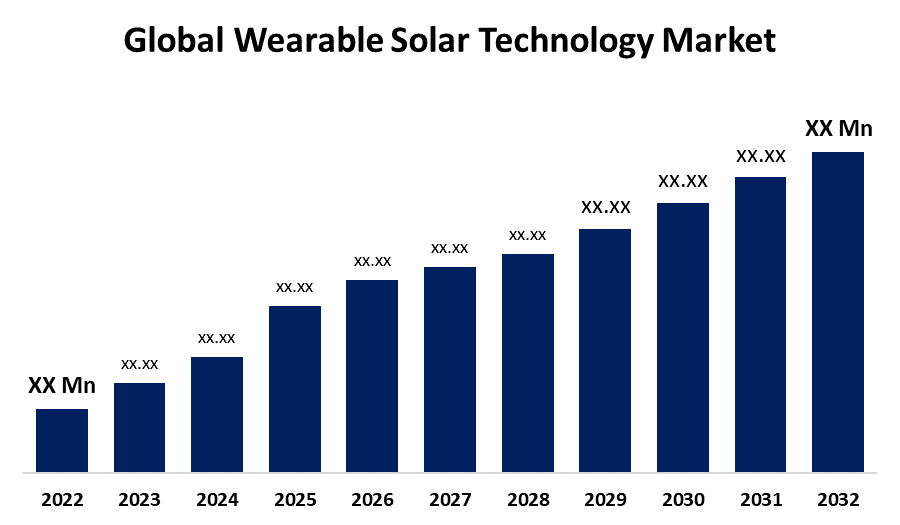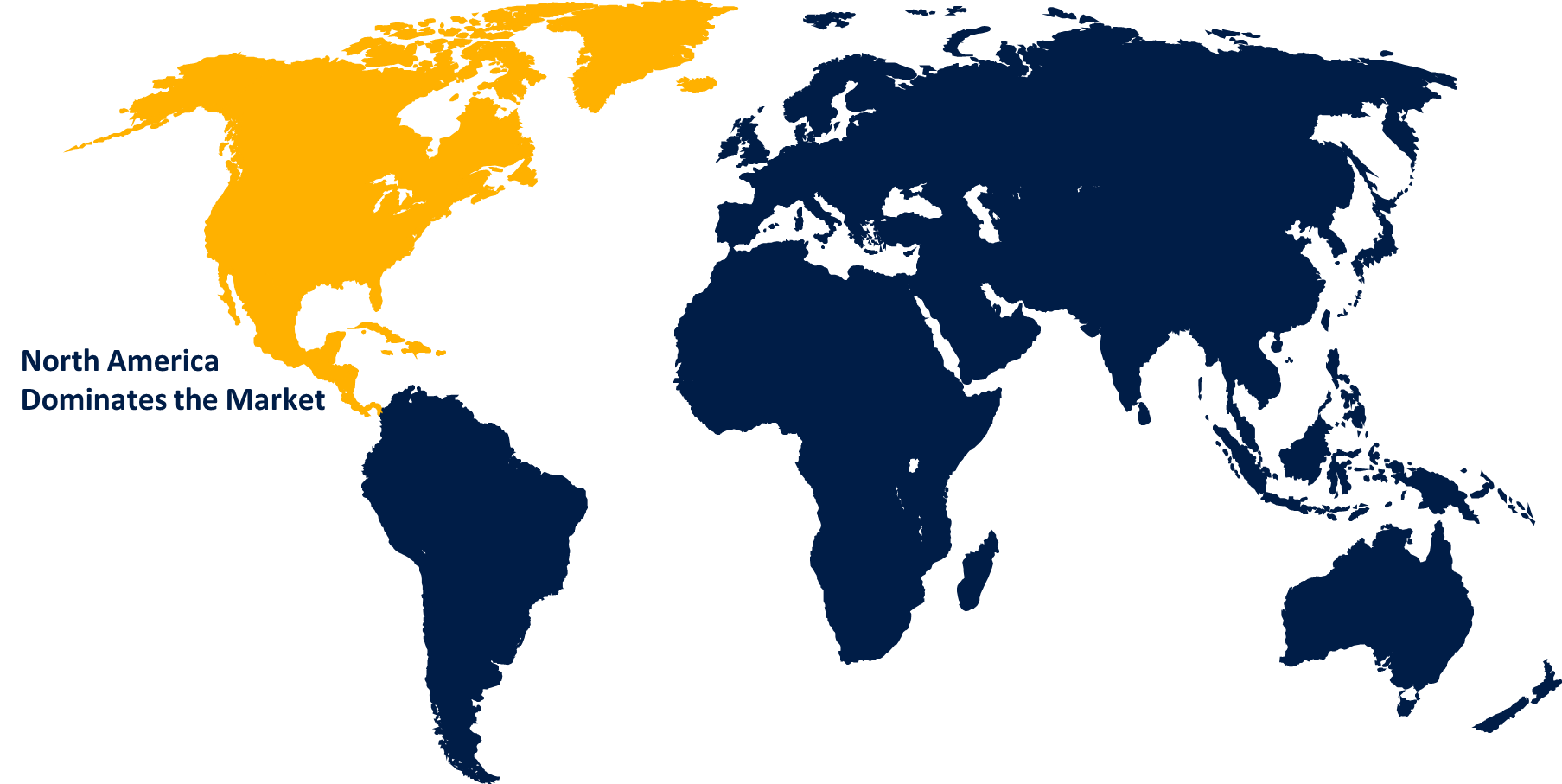Global Wearable Solar Technology Market Size, Share, and COVID-19 Impact Analysis, By Component (Solar Cell, Supercapacitors, Solar Panels, Sensors, Others), By Application (Smart watches, Headsets, Fitness Trackers, Smart Glasses, Smart Clothes & Fabrics, Footwear, Others), By End-use (Medical & Healthcare, Consumer Electronics, Textiles, Others), and By Region (North America, Europe, Asia-Pacific, Latin America, Middle East, and Africa), Analysis and Forecast 2022 - 2032
Industry: Consumer GoodsGlobal Wearable Solar Technology Market Insights Forecasts to 2032
- The Global Wearable Solar Technology Market Size was valued at USD XX Million in 2022.
- The Market Size is growing at a CAGR of 18.3% from 2022 to 2032
- The Worldwide Wearable Solar Technology Market Size is expected to reach USD XX Million by 2032
- Asia Pacific is expected to grow the fastest during the forecast period

Get more details on this report -
The Global Wearable Solar Technology Market Size is expected to reach USD XX Million by 2032, at a CAGR of 18.3% during the forecast period 2022 to 2032.
A wearable solar device works with electricity generated by solar energy. This device can charge portable electronics and wearable devices such as mobile phones and fitness bands. Growing demand for compact or lightweight portable electronics and thin film devices has contributed to the growth of the wearable solar technology market. Increasing demand for low-power consumption and long-life devices has also had a positive impact on the demand for photovoltaic cells, influencing the adoption of solar-powered wearables. Furthermore, high investments or initiatives toward solar power generation projects from both the government and power generation industries, as well as rising demand for smart wearables such as smart watches, fitness trackers, and many others as a result of growing health and lifestyle concerns, can drive the need for leveraging solar power as a substitute for offering to charge or discharging application areas.
Global Wearable Solar Technology Market Report Coverage
| Report Coverage | Details |
|---|---|
| Base Year: | 2022 |
| Forecast Period: | 2022-2032 |
| Forecast Period CAGR 2022-2032 : | 18.3% |
| Historical Data for: | 2019-2021 |
| No. of Pages: | 249 |
| Tables, Charts & Figures: | 120 |
| Segments covered: | By Component, By Application, ), By End-use, By Region |
| Companies covered:: | Fraunhofer-Gesellschaft, Tommy Hilfiger Licensing, LLC, SolarGoPack, Colorado Instruments, Inc, BirkSun, CASIO COMPUTER CO., LTD, LuisVanita, e5solar, Voltaic Systems, Lumos, and Other Key Players. |
| Pitfalls & Challenges: | COVID-19 Empact,Challenges, Future, Growth, & Analysis |
Get more details on this report -
Driving Factors
Government initiatives or regulations promoting the use of solar technology are a major driver of the wearable solar technology market growth. The government has placed a high priority on enacting regulations to reduce carbon emissions, as well as promoting favorable incentives or schemes to encourage the shift of end-use sectors toward solar-powered devices. One of the major drivers in the growth of the wearable solar technology market is the increasing number of research works on clothing or textiles harnessing solar energy. With changing consumer preferences and the textile industry's continued innovation, various vendors have focused on developing wearable products that leverage solar technology. Photovoltaic solar cells, solar modules, and other research projects have grown significantly, driving the need for portable charging of users devices. Trends such as changing the color of footwear or clothing when exposed to sunlight have gained widespread popularity in consumer markets, driving the demand for solar-powered components.
Restraining Factors
High-Cost factor restraining the growth of wearable solar technology market. In spite of the fact that solar energy is abundant in nature, the costs associated with extracting or harnessing it make it more expensive than traditional powered electricity models. Manufacturing and design complexities associated with components such as solar chipsets or modules, solar cells, and many others add to market vendors overall costs. This necessitates the use of skilled professionals to avoid design flaws that may contribute to the improper operation of the integrated devices. Such factors eventually affect the pricing structure of solar power-consuming wearables, restraining wearable solar technology market growth.
Market Segmentation
By Component Insights
The solar cells segment dominates the market with the largest revenue share over the forecast period.
Based on component, the global wearable solar technology market is segmented into solar cell, supercapacitors, solar panels, sensors, and others. Among these, the solar cells segment is dominating the market with the largest revenue share over the forecast period. As solar energy systems have emerged as an ideal alternative due to their high-power stability, mechanical robustness, and other advantages over other energy sources, the demand for solar cells for wearable device applications has been significantly impacted. Traditional silicon-based solar cells have been widely used for many years due to their ease of integration with wearable devices or products. Developments toward increasing demand for small, lightweight, and energy-efficient wearables at reasonable prices have fueled the need for smaller device designs to be integrated with simplified components with long service lives, propelling global wearable solar technology market growth over the forecast period.
By Application Insights
The smart watches segment is expected to hold the rapid revenue growth of the global Wearable Solar Technology market during the forecast period.
Based on application, the global wearable solar technology market is classified into smart watches, headsets, fitness trackers, smart glasses, smart clothes & fabrics, footwear, others. Among these, the smart watches segment is expected to grow at a rapid pace during the forecast period. Smartwatches have grown in popularity as a result of technological advancements in the consumer electronics sector, as well as growing concerns about health and fitness. Because solar-powered smart watches can be charged quickly and require fewer battery changes, they are a better option than traditional smartwatches. Furthermore, smart watches that use solar technology are more energy efficient due to longer battery life and power conservation capabilities. This allows consumers to save money on replacement costs from time to time, which has a positive impact on the wearable solar technology market’s growth.
By End-Use Insights
The medical & healthcare segment is expected to grow at the fastest pace in the global wearable solar technology market during the forecast period.
On the basis of end-use, the global wearable solar technology market is segmented into medical & healthcare, consumer electronics, textiles, and others. Among these, the medical & healthcare segment is expected to grow at the fastest pace in the global wearable solar technology market during the forecast period. The growth can be attributed due to the increasing adoption of health monitoring devices. Wearable solar technology in the medical and healthcare segment involves the integration of solar panels into medical devices and health monitoring wearables. Sensors, continuous monitoring systems, and other healthcare applications can be powered by these devices. Solar-powered medical wearables have a longer battery life, which reduces the need for frequent recharging or battery replacements, which is critical for continuous monitoring and data collection. It is used in medical devices such as continuous glucose monitors, wearable ECG monitors, and drug delivery systems.
Regional Insights
North America is expected to hold a significant share of the global wearable solar technology market during the forecast period.

Get more details on this report -
North America is expected to hold a significant share of the global wearable solar technology market during the forecast period. North America, particularly the United States, is a significant market for wearable solar technology. The region has a strong tech-savvy consumer base, and many companies are investing in developing innovative wearables. High consumer awareness, demand for smartwatches, fitness trackers, and other wearables, and a growing focus on sustainability and clean energy are all factors expected to drive the North American market.
Asia-Pacific market is expected to grow the fastest during the forecast period. Asia-Pacific, including countries like China, Japan, and South Korea, is a rapidly growing market for wearable solar technology. Rapid urbanization, rising disposable income, and a tech-savvy population, particularly in urban areas, are all factors expected to strengthen the market. The region's large population and booming technology sector create substantial opportunities for manufacturers.
List of Key Market Players
- Fraunhofer-Gesellschaft
- Tommy Hilfiger Licensing, LLC
- SolarGoPack
- Colorado Instruments, Inc
- BirkSun
- CASIO COMPUTER CO., LTD
- LuisVanita
- e5solar
- Voltaic Systems
- Lumos
- Others
Key Market Developments
- In April 2021, Fossil announced the release of the World-Timer, a limited-edition Solar Watch with solar-powered movement and a rechargeable battery.
- In May 2020, Garmin has announced the release of the Quatix 6X Solar, a new addition to its marine GPS smartwatch product line. This smartwatch has a transparent solar charging display, allowing it to use the sun's energy to extend battery life.
Market Segment
This study forecasts revenue at global, regional, and country levels from 2022 to 2032. Spherical Insights has segmented the global wearable solar technology market based on the below-mentioned segments:
Wearable Solar Technology Market, Component Analysis
- Solar Cell
- Supercapacitors
- Solar Panels
- Sensors
- Others
Wearable Solar Technology Market, Application Analysis
- Smart watches
- Headsets
- Fitness Trackers
- Smart Glasses
- Smart Clothes & Fabrics
- Footwear
- Others
Wearable Solar Technology Market, End-Use Analysis
- Medical & Healthcare
- Consumer Electronics
- Textiles
- Others
Wearable Solar Technology Market, Regional Analysis
- North America
- US
- Canada
- Mexico
- Europe
- Germany
- Uk
- France
- Italy
- Spain
- Russia
- Rest of Europe
- Asia Pacific
- China
- Japan
- India
- South Korea
- Australia
- Rest of Asia Pacific
- South America
- Brazil
- Argentina
- Rest of South America
- Middle East & Africa
- UAE
- Saudi Arabia
- Qatar
- South Africa
- Rest of the Middle East & Africa
Need help to buy this report?